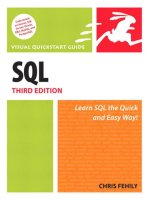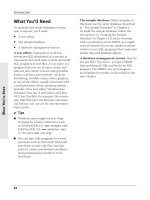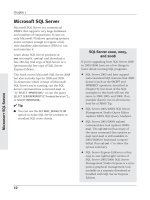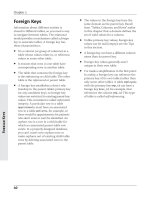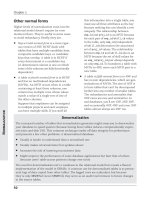SQL VISUAL QUICKSTART GUIDE- P24 ppsx
Bạn đang xem bản rút gọn của tài liệu. Xem và tải ngay bản đầy đủ của tài liệu tại đây (168.15 KB, 10 trang )
Creating an Inner Join
with INNER JOIN
An inner join:
◆
Uses a comparison operator (
=
,
<>
,
<
,
<=
,
>
, or
>=
) to match rows from two tables
based on the values in common columns
from each table. You can retrieve all rows
in which the author identifier (the column
au_id
) is the same in both the tables
authors
and
title_authors
, for example.
◆
Returns a result that contains only joined
rows that satisfy the join condition(s).
◆
Is the most common type of join.
To create an inner join:
◆
Type:
SELECT columns
FROM table1
INNER JOIN table2
ON join_conditions
columns is one or more comma-separated
expressions or column names from table1
or table2. table1 and table2 are the names
of the joined tables. If the tables have
some column names in common, qualify
those column names with the names of
the tables.
join_conditions specifies one or more
join conditions to be evaluated for each
pair of joined rows. A join condition
takes this form:
[table1.]column op [table2.]column
op usually is
=
but can be any compari-
son operator:
=
,
<>
,
<
,
<=
,
>
, or
>=
(refer
to Table 4.2 in Chapter 4). You can com-
bine multiple join conditions with
AND
or
OR
; see “Combining and Negating
Conditions with
AND, OR,
and
NOT
” in
Chapter 4.
✔ Tips
■
To create an inner join of three or more
tables by using
JOIN
syntax, type:
SELECT columns
FROM table1
INNER JOIN table2
ON join_condition1
INNER JOIN table3
ON join_condition2
Using
WHERE
syntax, type:
SELECT columns
FROM table1, table2,
WHERE join_condition1
AND join_condition2
■
If you’re using
WHERE
syntax and you
omit a join condition accidentally, you’ll
create a cross join. If the affected tables
are large production tables, you’ll have a
“runaway query” that you might have to
ask your database administrator to kill.
■
By default,
JOIN
(without
CROSS
,
NATURAL
,
OUTER
, or any other modifiers) is equiva-
lent to
INNER JOIN
.
210
Chapter 7
Creating an Inner Join with INNER JOIN
■
You can use
WHERE
syntax or
JOIN
syntax in Microsoft
Access, but if you use
JOIN
syntax in
joins that involve three or more tables,
Access requires you to nest joins by
using the following general syntax:
SELECT columns
FROM table1
INNER JOIN (table2
INNER JOIN (table3
INNER JOIN (table4
INNER JOIN )
ON table3.column3 op table4.column4)
ON table2.column2 op table3.column3)
ON table1.column1 op table2.column2;
(Other DBMSs also let you nest joins by
using parentheses, but Access requires it.)
Oracle 8i doesn’t support
JOIN
syntax;
use
WHERE
joins instead. Oracle 9i and
later support
JOIN
syntax.
Listing 7.7 joins two tables on the column
au_id
to list the books that each author
wrote (or cowrote). Each author’s
au_id
in
the table
authors
matches zero or more rows
in the table
title_authors
. See Figure 7.7
for the result. Note that author A07 (Paddy
O’Furniture) is omitted from the result
because he has written no books and so has
no matching rows in
title_authors
.
✔ Tip
■
Using
WHERE
syntax, Listing 7.7 is equiva-
lent to:
SELECT a.au_id, a.au_fname,
a.au_lname, ta.title_id
FROM authors a, title_authors ta
WHERE a.au_id = ta.au_id
ORDER BY a.au_id ASC,
ta.title_id ASC;
211
Joins
Creating an Inner Join with INNER JOIN
Listing 7.7 List the books that each author wrote (or
cowrote). See Figure 7.7 for the result.
SELECT
a.au_id,
a.au_fname,
a.au_lname,
ta.title_id
FROM authors a
INNER JOIN title_authors ta
ON a.au_id = ta.au_id
ORDER BY a.au_id ASC, ta.title_id ASC;
Listing
au_id au_fname au_lname title_id
A01 Sarah Buchman T01
A01 Sarah Buchman T02
A01 Sarah Buchman T13
A02 Wendy Heydemark T06
A02 Wendy Heydemark T07
A02 Wendy Heydemark T10
A02 Wendy Heydemark T12
A03 Hallie Hull T04
A03 Hallie Hull T11
A04 Klee Hull T04
A04 Klee Hull T05
A04 Klee Hull T07
A04 Klee Hull T11
A05 Christian Kells T03
A06 Kellsey T08
A06 Kellsey T09
A06 Kellsey T11
Figure 7.7 Result of Listing 7.7.
Listing 7.8 joins two tables on the column
pub_id
to list each book’s title name and ID,
and each book’s publisher name and ID.
Note that the join is necessary to retrieve
only the publisher name (the fourth column
in the result); all the other three columns are
available in the table
titles
. See Figure 7.8
for the result.
✔ Tip
■
Using
WHERE
syntax, Listing 7.8 is equiva-
lent to:
SELECT t.title_id, t.title_name,
t.pub_id, p.pub_name
FROM titles t, publishers p
WHERE p.pub_id = t.pub_id
ORDER BY t.title_name ASC;
212
Chapter 7
Creating an Inner Join with INNER JOIN
Listing 7.8 List each book’s title name and ID and
each book’s publisher name and ID. See Figure 7.8 for
the result.
SELECT
t.title_id,
t.title_name,
t.pub_id,
p.pub_name
FROM titles t
INNER JOIN publishers p
ON p.pub_id = t.pub_id
ORDER BY t.title_name ASC;
Listing
title_id title_name pub_id pub_name
T01 1977! P01 Abatis Publishers
T02 200 Years of German Humor P03 Schadenfreude Press
T03 Ask Your System Administrator P02 Core Dump Books
T04 But I Did It Unconsciously P04 Tenterhooks Press
T05 Exchange of Platitudes P04 Tenterhooks Press
T06 How About Never? P01 Abatis Publishers
T07 I Blame My Mother P03 Schadenfreude Press
T08 Just Wait Until After School P04 Tenterhooks Press
T09 Kiss My Boo-Boo P04 Tenterhooks Press
T10 Not Without My Faberge Egg P01 Abatis Publishers
T11 Perhaps It's a Glandular Problem P04 Tenterhooks Press
T12 Spontaneous, Not Annoying P01 Abatis Publishers
T13 What Are The Civilian Applications? P03 Schadenfreude Press
Figure 7.8 Result of Listing 7.8.
Listing 7.9 uses two join conditions to list
the authors who live in the same city and
state as some publisher (any publisher). See
Figure 7.9 for the result. Note that this
query is a natural join on the identically
named, nonkey columns
city
and
state
in
the two tables (see “Creating a Natural Join
with
NATURAL JOIN
” earlier in this chapter).
An equivalent query is:
SELECT a.au_id, a.au_fname,
a.au_lname, a.city, a.state
FROM authors a
NATURAL JOIN publishers p
ORDER BY a.au_id ASC;
✔ Tip
■
Using
WHERE
syntax, Listing 7.9 is equiva-
lent to:
SELECT a.au_id, a.au_fname,
a.au_lname, a.city, a.state
FROM authors a, publishers p
WHERE a.city = p.city
AND a.state = p.state
ORDER BY a.au_id ASC;
213
Joins
Creating an Inner Join with INNER JOIN
Listing 7.9 List the authors who live in the same
city and state in which a publisher is located. See
Figure 7.9 for the result.
SELECT
a.au_id,
a.au_fname,
a.au_lname,
a.city,
a.state
FROM authors a
INNER JOIN publishers p
ON a.city = p.city
AND a.state = p.state
ORDER BY a.au_id;
Listing
au_id au_fname au_lname city state
A03 Hallie Hull San Francisco CA
A04 Klee Hull San Francisco CA
A05 Christian Kells New York NY
Figure 7.9 Result of Listing 7.9.
Listing 7.10 combines an inner join with
WHERE
conditions to list books published in
California or outside the large North American
countries; see “Filtering Rows with
WHERE
” in
Chapter 4. See Figure 7.10 for the result.
✔ Tip
■
Using
WHERE
syntax, Listing 7.10 is equiv-
alent to:
SELECT t.title_id, t.title_name,
p.state, p.country
FROM titles t, publishers p
WHERE t.pub_id = p.pub_id
AND (p.state = ‘CA’
OR p.country NOT IN
(‘USA’, ‘Canada’, ‘Mexico’))
ORDER BY t.title_id ASC;
214
Chapter 7
Creating an Inner Join with INNER JOIN
Listing 7.10 List the books published in California or
outside the large North American countries. See
Figure 7.10 for the result.
SELECT
t.title_id,
t.title_name,
p.state,
p.country
FROM titles t
INNER JOIN publishers p
ON t.pub_id = p.pub_id
WHERE p.state = 'CA'
OR p.country NOT IN ('USA', 'Canada',
'Mexico')
ORDER BY t.title_id ASC;
Listing
title_id title_name state country
T02 200 Years of German Humor NULL Germany
T03 Ask Your System Administrator CA USA
T04 But I Did It Unconsciously CA USA
T05 Exchange of Platitudes CA USA
T07 I Blame My Mother NULL Germany
T08 Just Wait Until After School CA USA
T09 Kiss My Boo-Boo CA USA
T11 Perhaps It's a Glandular Problem CA USA
T13 What Are The Civilian Applications? NULL Germany
Figure 7.10 Result of Listing 7.10.
Listing 7.11 combines an inner join with
the aggregate function
COUNT()
and a
GROUP
BY
clause to list the number of books that
each author wrote (or cowrote). For infor-
mation about aggregate functions and
GROUP
BY
, see Chapter 6. See Figure 7.11 for the
result. Note that, as in Figure 7.7, author A07
(Paddy O’Furniture) is omitted from the
result because he has written no books and
so has no matching rows in
title_authors
.
See Listing 7.30 in “Creating Outer Joins
with
OUTER JOIN
” later in this chapter for an
example that lists authors who have written
no books.
✔ Tip
■
Using
WHERE
syntax, Listing 7.11 is equiv-
alent to:
SELECT a.au_id,
COUNT(ta.title_id)
AS “Num books”
FROM authors a, title_authors ta
WHERE a.au_id = ta.au_id
GROUP BY a.au_id
ORDER BY a.au_id ASC;
215
Joins
Creating an Inner Join with INNER JOIN
Listing 7.11 List the number of books that each author
wrote (or cowrote). See Figure 7.11 for the result.
SELECT
a.au_id,
COUNT(ta.title_id) AS "Num books"
FROM authors a
INNER JOIN title_authors ta
ON a.au_id = ta.au_id
GROUP BY a.au_id
ORDER BY a.au_id ASC;
Listing
au_id Num books
A01 3
A02 4
A03 2
A04 4
A05 1
A06 3
Figure 7.11 Result of Listing 7.11.
Listing 7.12 uses
WHERE
conditions to list
the advance paid for each biography. See
Figure 7.12 for the result.
✔ Tip
■
Using
WHERE
syntax, Listing 7.12 is equiv-
alent to:
SELECT t.title_id, t.title_name,
r.advance
FROM royalties r, titles t
WHERE r.title_id = t.title_id
AND t.type = ‘biography’
AND r.advance IS NOT NULL
ORDER BY r.advance DESC;
216
Chapter 7
Creating an Inner Join with INNER JOIN
Listing 7.12 List the advance paid for each biography.
See Figure 7.12 for the result.
SELECT
t.title_id,
t.title_name,
r.advance
FROM royalties r
INNER JOIN titles t
ON r.title_id = t.title_id
WHERE t.type = 'biography'
AND r.advance IS NOT NULL
ORDER BY r.advance DESC;
Listing
title_id title_name advance
T07 I Blame My Mother 1000000.00
T12 Spontaneous, Not Annoying 50000.00
T06 How About Never? 20000.00
Figure 7.12 Result of Listing 7.12.
Listing 7.13 uses aggregate functions and a
GROUP BY
clause to list the count and total
advance paid for each type of book. See
Figure 7.13 for the result.
✔ Tip
■
Using
WHERE
syntax, Listing 7.13 is equiv-
alent to:
SELECT t.type,
COUNT(r.advance)
AS “COUNT(r.advance)”,
SUM(r.advance)
AS “SUM(r.advance)”
FROM royalties r, titles t
WHERE r.title_id = t.title_id
AND r.advance IS NOT NULL
GROUP BY t.type
ORDER BY t.type ASC;
217
Joins
Creating an Inner Join with INNER JOIN
Listing 7.13 List the count and total advance paid for
each type of book. See Figure 7.13 for the result.
SELECT
t.type,
COUNT(r.advance)
AS "COUNT(r.advance)",
SUM(r.advance)
AS "SUM(r.advance)"
FROM royalties r
INNER JOIN titles t
ON r.title_id = t.title_id
WHERE r.advance IS NOT NULL
GROUP BY t.type
ORDER BY t.type ASC;
Listing
type COUNT(r.advance) SUM(r.advance)
biography 3 1070000.00
children 2 0.00
computer 1 15000.00
history 3 31000.00
psychology 3 220000.00
Figure 7.13 Result of Listing 7.13.
Listing 7.14 is similar to Listing 7.13,
except that it uses an additional grouping
column to list the count and total advance
paid for each type of book by publisher. See
Figure 7.14 for the result.
✔ Tip
■
Using
WHERE
syntax, Listing 7.14 is equiv-
alent to:
SELECT t.type, t.pub_id,
COUNT(r.advance)
AS “COUNT(r.advance)”,
SUM(r.advance)
AS “SUM(r.advance)”
FROM royalties r, titles t
WHERE r.title_id = t.title_id
AND r.advance IS NOT NULL
GROUP BY t.type, t.pub_id
ORDER BY t.type ASC, t.pub_id ASC;
218
Chapter 7
Creating an Inner Join with INNER JOIN
Listing 7.14 List the count and total advance paid for
each type of book, by publisher. See Figure 7.14 for
the result.
SELECT
t.type,
t.pub_id,
COUNT(r.advance) AS "COUNT(r.advance)",
SUM(r.advance) AS "SUM(r.advance)"
FROM royalties r
INNER JOIN titles t
ON r.title_id = t.title_id
WHERE r.advance IS NOT NULL
GROUP BY t.type, t.pub_id
ORDER BY t.type ASC, t.pub_id ASC;
Listing
type pub_id COUNT(r.advance) SUM(r.advance)
biography P01 2 70000.00
biography P03 1 1000000.00
children P04 2 0.00
computer P02 1 15000.00
history P01 1 10000.00
history P03 2 21000.00
psychology P04 3 220000.00
Figure 7.14 Result of Listing 7.14.
Listing 7.15 uses a
HAVING
clause to list the
number of coauthors of each book written
by two or more authors. For information
about
HAVING
, see “Filtering Groups with
HAVING
” in Chapter 6. See Figure 7.15 for
the result.
✔ Tip
■
Using
WHERE
syntax, Listing 7.15 is equiv-
alent to:
SELECT ta.title_id,
COUNT(ta.au_id) AS “Num authors”
FROM authors a, title_authors ta
WHERE a.au_id = ta.au_id
GROUP BY ta.title_id
HAVING COUNT(ta.au_id) > 1
ORDER BY ta.title_id ASC;
219
Joins
Creating an Inner Join with INNER JOIN
Listing 7.15 List the number of coauthors of each
book written by two or more authors. See Figure 7.15
for the result.
SELECT
ta.title_id,
COUNT(ta.au_id) AS "Num authors"
FROM authors a
INNER JOIN title_authors ta
ON a.au_id = ta.au_id
GROUP BY ta.title_id
HAVING COUNT(ta.au_id) > 1
ORDER BY ta.title_id ASC;
Listing
title_id Num authors
T04 2
T07 2
T11 3
Figure 7.15 Result of Listing 7.15.
